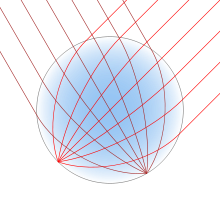
Back Lent de Luneberg Catalan Lüneburg-Linse German Lente de Lüneburg Spanish Լյունեբերգի ոսպնյակ Armenian Lüneburglens Dutch Soczewka Luneburga Polish Линза Люнеберга Russian Lüneburg-Lins Swedish 龙伯透镜 Chinese

A Luneburg lens (original German Lüneburg lens) is a spherically symmetric gradient-index lens. A typical Luneburg lens's refractive index n decreases radially from the center to the outer surface. They can be made for use with electromagnetic radiation from visible light to radio waves.
For certain index profiles, the lens will form perfect geometrical images of two given concentric spheres onto each other. There are an infinite number of refractive-index profiles that can produce this effect. The simplest such solution was proposed by Rudolf Luneburg in 1944.[1] Luneburg's solution for the refractive index creates two conjugate foci outside the lens. The solution takes a simple and explicit form if one focal point lies at infinity, and the other on the opposite surface of the lens. J. Brown and A. S. Gutman subsequently proposed solutions which generate one internal focal point and one external focal point.[2][3] These solutions are not unique; the set of solutions are defined by a set of definite integrals which must be evaluated numerically.[4]
- ^ Cite error: The named reference
luneburgwas invoked but never defined (see the help page). - ^ Brown, J. (1953). Wireless Engineer. 30: 250.
{{cite journal}}: Missing or empty|title=(help) - ^ Gutman, A. S. (1954). "Modified Luneberg Lens". J. Appl. Phys. 25 (7): 855–859. Bibcode:1954JAP....25..855G. doi:10.1063/1.1721757.
- ^ Morgan, S. P. (1958). "General solution of the Luneburg lens problem". J. Appl. Phys. 29 (9): 1358–1368. Bibcode:1958JAP....29.1358M. doi:10.1063/1.1723441. S2CID 119949981.
© MMXXIII Rich X Search. We shall prevail. All rights reserved. Rich X Search